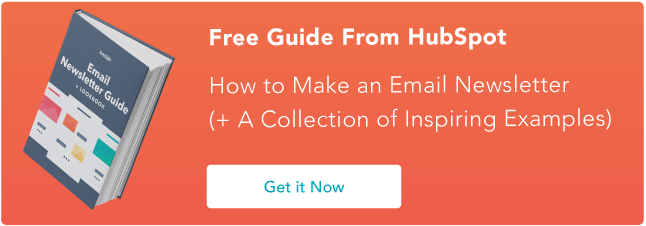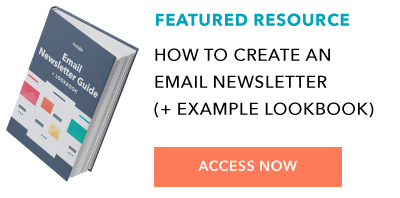How to Write a Marketing Email: 10 Tips for Writing Strong Email Copy
Email marketing remains crucial to most marketing campaigns. However, not every marketer knows how to write a marketing email that will boost conversions and audience retention.
If your marketing emails aren’t well-written, your subscribers will stop opening and start deleting your messages.
This article will break down best practices for an effective email that will boost your next lead-nurturing campaign.
10 Email Copywriting Tips for Writing Better Marketing Emails
We’ll start with copywriting tips for better subject lines, followed by copywriting tips for the bodies of your emails.
How to Write a Subject Line
Part of writing effective email copy is nailing the subject line.
The subject line is like the gatekeeper of your email: No one gets to read your stellar email copy if they aren’t interested enough to open your email in the first place.
That interest is garnered almost wholly on the email’s subject line (with the sender’s name also playing a role).
We’ve written a few blog posts about crafting email subject lines, including one showing 157 examples of awesome subject lines from brands.
Here’s a distillation of what you need to know to write some excellent copy.
1. Use actionable language.
With email subject lines, using actionable language doesn’t necessarily mean using verbs, although it certainly helps. OpenTable, for example, sent me an email that said “Take Mom to Brunch” in the subject line.
This is one way to use actionable language effectively in email subject lines: by incorporating a verb (like “take,” “download,” “reserve,” “ask,” “buy,” etc.), the reader knows exactly what they can do in the email.
But there are ways to use actionable language without relying on verbs, which gives you more room to play around with wording.
It comes down to using language that clarifies to the recipient what they can do with the information in the email, should they choose to open it. In other words, keep the value for the user top-of-mind.
For example, I once got an email from TicketMaster with the subject line “Don’t Miss Bruce Springsteen and the E Street Band.”
They didn’t order me to purchase tickets by saying, “Purchase Tickets Tomorrow for Bruce Springsteen and the E Street Band,” though such a subject line may have performed just as well.
The original subject line worked well because it was clear what I could do with the information in that email — ensure I’m prepared for the 10:00 AM sale time so I could snag my tickets. (Which I did, thanks to that email!)
2. Personalize when possible.
Highly segmented emails tend to have higher performance levels — such as open rate and clickthrough rate — than emails that aren’t personalized.
Our research found that the most effective strategies for email marketing campaigns are subscriber segmentation (78%), message personalization (72%), and email automation campaigns (71%).
This isn’t exactly surprising. After all, the more segmented your email list, the better you can personalize the subject line and provide relevant content to that email recipient.
So ask yourself: Can you make your email subject line more personal?
And I’m not talking about the dynamic field where you insert someone’s first name — email recipients stopped being impressed by that fancy functionality some time ago.
Consider this scenario instead: You’re a realtor with a huge database of clients:
- Some of them are looking to rent, while others prefer to buy.
- Their ideal location ranges across several cities and zip codes.
- They all have different price points with which they’re comfortable.
- Some are looking for a studio, while others want a mansion.
- You even know that a group of them will only accept homes that have been renovated in the past 5 years.
You certainly wouldn’t do a blanket email send across all of these different segments of your list, would you?
And your email subject line wouldn’t be the same, either.
You might have one subject line, “Renovated 1BR Apartment for Rent in Cambridge: Schedule a Viewing,” and another, “RSVP: Open House Sunday for Colonial House in Sudbury.”
Each subject line speaks to the radically different needs of two radically different list segments.
If you’re struggling with personalizing emails or looking to save time, HubSpot boasts a range of email marketing tools to help you create, personalize, and optimize your emails.
Furthermore, our campaign assistant can generate marketing emails to quickly and effectively reach your consumers.
3. Prioritize clarity, and only then think about “catchiness.”
Write a subject line that is clear first, and catchy second. In marketing copy, clarity should always be your first priority.
If, after you’ve drafted a clear subject line, you can also make it catchy, funny, cute, whimsical, or whatever — then go for it. But never sacrifice clarity for entertainment value.
UrbanDaddy is an example of a company that excels at writing subject lines that are always clear, and sometimes also catchy, funny, or entertaining.
Take a look at the subject lines of some of the emails I’ve received from them:
UD | A Hotel in the Middle of the Ocean
UD | Nunchucks. Made from Beer Cans. Finally.
UD | Getting Everyone Together: Now Less Obnoxious
UD | A Grill the Size of a Foosball Table
UD | It’s Ice Cream. It’s Beer. It’s Beer Ice Cream.
UD | Here’s a Private Bahamian Island. Do Your Thing.
Some of these subject lines either make the recipients chuckle or are bizarre enough to pique your interest. But it is always extremely clear what you will get when you open the email.
4. Align your subject line copy and email copy.
It’s crucial for your call-to-action copy and your landing page offer to align. Well, it’s no different when crafting your email subject line and email message.
What your email subject line promises, the email message should deliver.
Why?
It’s not just because it’s responsible — it’s also because click-through rates plummet when readers don’t get what they’re actually promised in the subject line. And, in the long term, so will your email open rates.
How to Write an Email
Now that you’ve crafted a stellar email subject line, you have your audience’s full attention on the body of your email message.
So, how do you craft copy that will get them clicking? Here are the important components you need to know!
5. Establish relevancy.
Just like the email subject line should strive to establish relevancy through personalization, so should the copy in the message of the email.
Again, it takes more than just a dynamic name tag for your email copy to convince readers that what’s inside is relevant to them. So use the very beginning of the email to explain how you know each other.
Below is an example of an email sent by Warby Parker to a colleague of mine.

Yes, the email opens by addressing my colleague’s first name; however, it takes it a step further by pointing out that Jana has not been opening her emails and could be missing out on some great trips.
It’s personal and gently says, “This could be you, but you’re not opening our emails.”
6. Write in the second-person.
Writing in the second-person means using the pronouns “you,” “your,” and “yours.” For example, “Before you leave in the morning, remember to bring your jacket.” It means you orient the copy towards the reader, not yourself.
Take a look at the copy in this email from Zappos, for example:
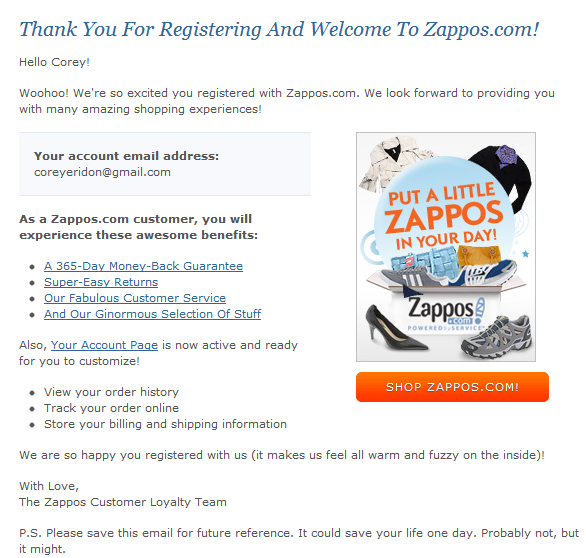
The words “you” and “your” appear 12 times, while “we,” “our,” and “we’re” appear only 5 times.
That’s a nice balance of second-person language that keeps the focus on the customer, not the brand. This subtle tactic helps you stay value-oriented, but this next step I’m about to cover is crucial to hitting the point home.
7. Talk about benefits, not features.
You know the value of your email, but does your recipient? No, not yet. And it’s your job to explain it.
The problem is that many emails only explain the feature they offer, not the benefit. Take a look at the copy in two separate e-commerce emails I’ve received.
Which one is touting the feature, and which is touting the benefit?
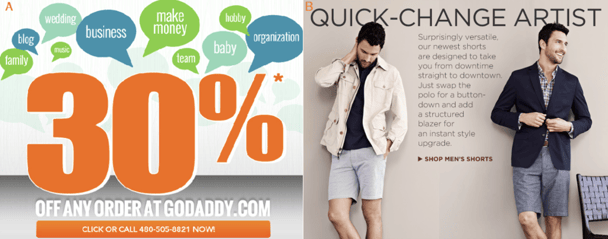 If you guessed email B, you’re right. Email A throws a 30% discount directly in your face but doesn’t explain the value behind it. What does 30% off a GoDaddy product do for my goals?
If you guessed email B, you’re right. Email A throws a 30% discount directly in your face but doesn’t explain the value behind it. What does 30% off a GoDaddy product do for my goals?
Will it let me adjust a small business’ expenditures on infrastructure costs, freeing up money for a new hire? That benefit is far more tangible than 30% off an undisclosed cost.
Compare that with Email B from Banana Republic. This email aims to sell shorts, but the copy isn’t just highlighting the product. They’ve identified what makes these shorts worthwhile: their versatility.
They allow a man to lounge around the house and go out in the city while putting minimal effort into changing his outfit. How convenient! How easy! How versatile!
The copy translates the benefit of buying those shorts, but the copy (or lack thereof) in GoDaddy’s email doesn’t explain the benefit of redeeming a generic 30% off offer.
8. Be brief.
One of the worst mistakes email copywriters make is trying to shove the entire story into the email message. Think about when you open a marketing email in your inbox.
Do you read every single word in there? Probably not. It’s more likely that you scan for important points to glean the overall message and decide whether you want to take action.
So if you’re sending an email with hundreds of words of copy, you’re making it much more difficult for recipients to decide whether they want to click through.
This is because they can’t quickly sift through all of the information in your email.
Instead, find a way to summarize what the reader will get in a compelling way, and let them click through to a page on your website for more information.
Take a look at how the folks over at Postmates drafted a brief email encouraging readers to click through for a limited-time offer:

Postmates doesn’t wait to get to the point. After a brief, friendly hello, they get right down to the purpose of the email: telling customers about their new “free lattes on-demand” promotion.
After introducing the concept, they offer some essential details, then get right to the call-to-action.
Keeping your message on-point is the key to writing brief email copy. What’s the point you’re trying to make with your email?
If you know the action your email is supposed to drive recipients to take action, you’ll have a much easier time drafting succinct email copy that remains focused on that one end goal.
Also, remember that having just one primary call-to-action in your email marketing results in better clickthrough rates than emails with competing calls-to-action.
9. Be lovable.
Just because emails are meant to inform doesn’t mean they can’t also delight.
In some cases, email can be a great avenue for letting your brand’s personality shine, helping you build a meaningful relationship with the folks on your email lists.
After all, providing a lovable experience for people begins and ends with how you communicate with them.
For example, check out the email below from Lazo’s Pizza. The email showcases the brand’s playful personality by playing a game (“pizza prequel”) and using relevant emojis.
Plus, who doesn’t love a good pizza pun?
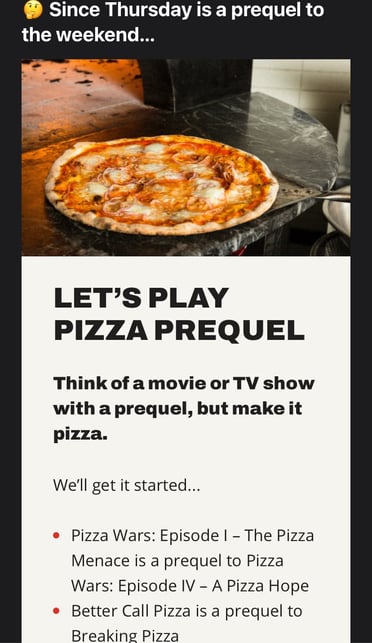
The email is a great example of how to delight your audience by humanizing your brand.
10. Use actionable language in your call-to-action.
Emails have calls to action, too. Well, the good ones do. First and foremost, your email call-to-action should be extremely easy to identify.
Remember: People scan their emails. If there’s one thing you want your recipient to pick up on, it’s your call to action.
If you’re sending an HTML email, you may decide to include a button, like this Spotify email did below.
 Notice that the button is a bright green color that stands out from the black background.
Notice that the button is a bright green color that stands out from the black background.
Furthermore, the most important information is in bold, such as the fact that tickets for James Blake are on sale and the date/location of his nearest concert.
Optimizing your plain-text emails for clear calls to action is also crucial.
No matter how fancy your HTML email is, not all email clients will render your images, and not all email recipients will choose to display your images.
In fact, we studied whether HTML emails or plain-text emails performed best.
Our study found that, while people say they prefer HTML-based and image-based emails, in reality, simpler emails perform best — and plain-text emails perform best of all.
Take a look at how one of our emails makes use of linked anchor text to draw recipients’ attention toward the calls-to-action:

The message doesn’t many graphics or colors added compared to most HTML emails. As such, the hyperlinked calls-to-action garner even more attention.
Bolded words, hyperlinked text, and reiterating the same offer over and over tells readers exactly what you want them to do — redeem your offer by clicking your call-to-action.
What else do you think makes for effective email marketing copy? Share with us in the comments.
Editor’s Note: This post was originally published in May 2012 and has been updated for freshness, accuracy, and comprehensiveness.
![]()



